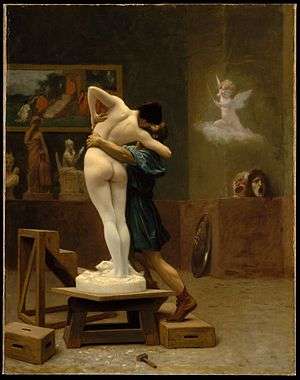Pygmalion and Galatea (Gérôme painting)
 | |
| Artist | Jean-Léon Gérôme |
|---|---|
| Year | 1890 |
| Medium | Oil on canvas |
| Dimensions | 89 cm × 69 cm (35 in × 27 in) |
| Location | Metropolitan Museum of Art, New York City |
Pygmalion and Galatea (French: Pygmalion et Galatée) is an 1890 painting by the French artist Jean-Léon Gérôme.[1] The motif is taken from Ovid's Metamorphoses, and depicts how the sculptor Pygmalion kisses his ivory statue Galatea, after the goddess Venus has brought her to life.
Creation
Jean-Léon Gérôme painted Pygmalion and Galatea in the summer of 1890. In 1891 he made a marble sculpture of the same subject, possibly based on a plaster version also used as model for the painting. He made several alternative versions of the painting, each presenting the subject from a different angle.[2]
Provenance
The most famous version, where Galatea is seen from behind, was bought by Boussod, Valadon & Cie on 22 March 1892. It was sold several times until it was donated to the Metropolitan Museum of Art by Louis C. Raegner in 1927. The other versions are in private collections or lost.[2]
References
| Wikimedia Commons has media related to Pygmalion and Galatea by Jean-Léon Gérôme. |
- ↑ Ackerman, Gerald M. (1986). The Life and Work of Jean-Léon Gérôme: with a Catalogue Raisonné. London; New York: Sotheby's Publications. p. 268. ISBN 9780856673115.
- 1 2 "Pygmalion and Galatea". Metropolitan Museum of Art. Retrieved 2016-05-07.